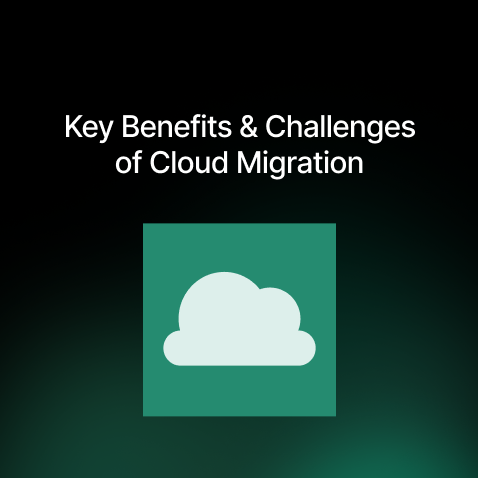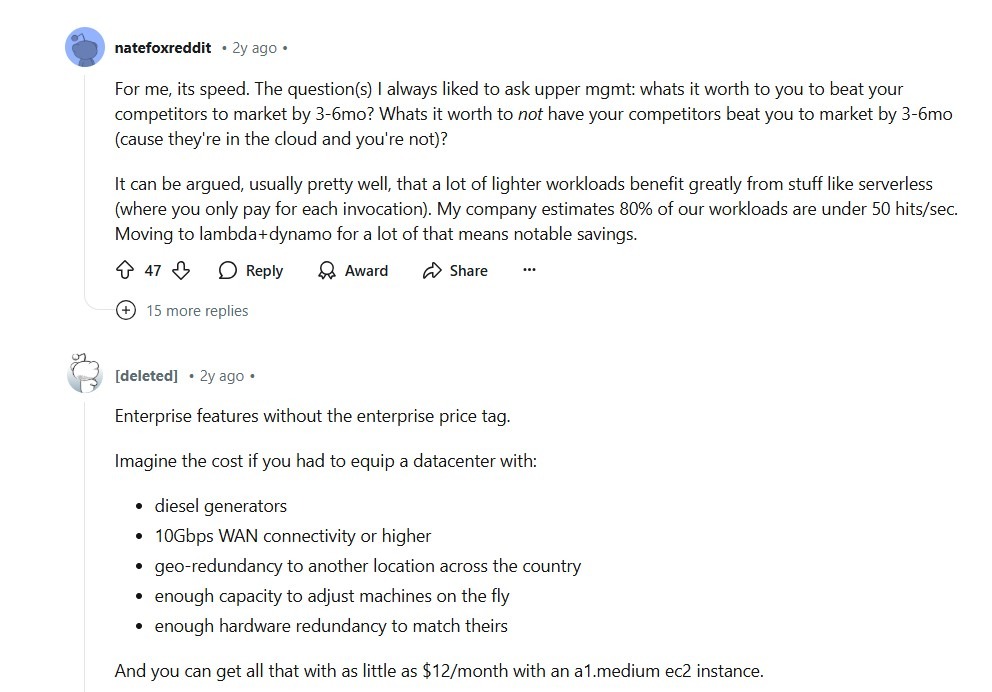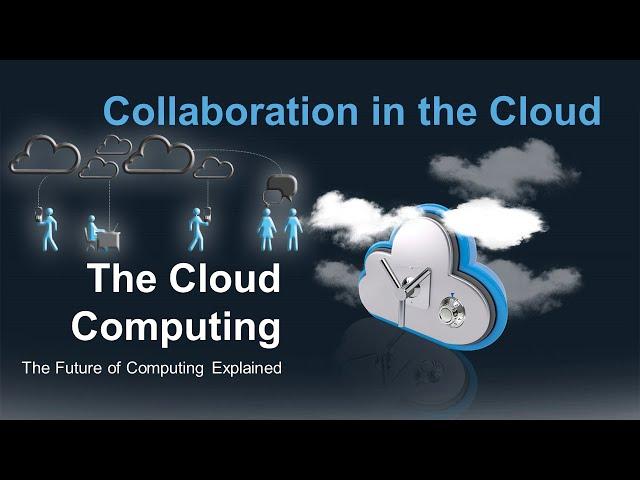Key Benefits and Challenges of Cloud Migration
- Nitin Yadav
- Blog
About

Unlock the benefits of cloud migration like scalability and cost-efficiency.
Industries
- AWS, AWS Secret Manager, DevOps, Terraform
Share Via
95% of companies express concerns about cloud security. Not a small number, is it? In contrast, 94% of organizations reported improvements in security after moving to the cloud.
What does this tell us? The benefits of migration are immense, but the potential vulnerabilities are just as threatening. Cloud migration service providers carefully navigate these nuances to ensure a successful transition.
Whether you are considering migrating to the cloud or are in the midst of the process, understanding crucial aspects, benefits, and challenges of cloud migration will empower you to make informed decisions and unlock the full potential of cloud computing for your organization.
Ready to go? Let’s dive into the good parts first.
Key Benefits of Cloud Migration

From organizational streamlining to cost efficiency, the benefits of cloud migration are plenty. Let’s look at them in detail below:
1.Scalability and Flexibility
Cloud migration allows businesses to easily adjust resources to meet demand fluctuations, which is essential for growing organizations. By leveraging the scalability of the cloud, companies can quickly scale up or down based on their needs, ensuring optimal resource utilization.


This conversation on Reddit focuses on the much-needed flexibility that cloud migration provides.
2. Cost Efficiency
One of the primary benefits of cloud migration is the shift from capital expenditure (CapEx) to operational expenditure (OpEx). With pay-as-you-go pricing models, businesses only pay for the resources they consume, reducing upfront costs and enabling better financial planning. This has led to worldwide cloud service spending growing by 20%.
3. Improved Collaboration and Accessibility
Cloud migration enhances collaboration by enabling remote access and seamless teamwork across different locations. Cloud-based tools and platforms allow employees to work together efficiently, regardless of their physical location, improving productivity and agility.

Want a deeper look into how this collaboration works? A video by Free Education Academy explains how it all functions.
4. Enhanced Security and Privacy
Advanced security features, including encryption and user access controls, ensure the data protection that cloud providers offer. By migrating to the cloud, businesses can benefit from these robust security measures, reducing the risk of data breaches and unauthorized access.
5. Innovation and Speed to Market
Cloud migration facilitates faster deployment of new solutions and enables organizations to leverage modern technologies. With the ability to quickly provision resources and iterate on ideas, businesses can accelerate innovation and reduce time to market for new products and services by choosing the right platform for the product.
6. Disaster Recovery and Business Continuity
Cloud providers offer geographically distributed infrastructure, enabling organizations to implement robust disaster recovery and business continuity plans. Businesses ensure high availability and minimize the impact of potential disruptions by replicating data and applications across multiple regions.
7. Reduced Maintenance
Cloud migration reduces the burden of maintenance and updates on internal IT resources. Cloud providers handle the underlying infrastructure, including hardware, security patches, compliance, and software updates, allowing organizations to focus on their core business activities.
Enticed by the benefits? Let’s also look at the other side of the coin – the challenges.
Challenges of Cloud Migration

71% of enterprises report difficulties in moving data into the cloud, often due to legacy infrastructure challenges. Let’s look at them in detail below:
1. Security Risks
While cloud providers implement stringent security measures, there are still risks associated with cloud migration. Misconfiguration and improper data handling can lead to potential vulnerabilities. Organizations must prioritize security and implement appropriate measures to mitigate these risks.
2. Legacy Infrastructure Compatibility
Migrating legacy systems to the cloud can be challenging. Significant modifications or replacements may be required for some older applications and infrastructure because they are not directly compatible with cloud environments. This can increase the complexity and cost of the migration process.

A Reddit thread goes deeper into this conversation, discussing all the difficulties with a legacy system.
3. Data Loss and Business Disruption
During the migration process, there is a risk of data loss or business disruption if not handled properly. Moving large volumes of data and ensuring minimal downtime requires careful planning and execution. Organizations must have robust data backup and recovery strategies in place.
4. Skill and Knowledge Gap
Cloud migration often requires specialized skills and knowledge. Organizations may face challenges in finding and retaining professionals with the necessary expertise to manage and optimize cloud environments effectively. Addressing this skill gap is crucial for successful migration and ongoing management.
5. Vendor Lock-In
Choosing a specific cloud provider can lead to vendor lock-in, where an organization becomes dependent on a single provider’s services and technologies. This can limit flexibility and make it difficult to switch providers in the future.
It’s best to choose a vendor that provides end-to-end cloud migration solutions so you never have to worry about switching.

Alright, with those challenges in mind, let’s dive into how you can successfully navigate them.
Overcoming Cloud Migration Challenges
1. Develop Comprehensive Plans
To mitigate risks and ensure a smooth migration, organizations should develop detailed migration plans. These plans should address potential challenges, outline clear objectives, and define the steps required for a successful transition. Thorough planning helps minimize disruptions and data loss.
2. Enhance Security Measures
Security remains a primary concern, with 79% of organizations identifying it as a significant challenge in cloud adoption. Implementing advanced encryption, access controls, and monitoring solutions can help safeguard sensitive data. Regular security audits and compliance checks should be conducted to identify and address any vulnerabilities.
3. Foster Skills Development
A lack of resources or expertise is cited by 78% of companies as a barrier to effective cloud migration. Organizations should invest in training and upskilling their existing staff to bridge the skill and knowledge gap. Providing opportunities for employees to acquire cloud-specific certifications and expertise ensures a smooth transition.
4. Incremental Transition
Adopting an incremental approach to cloud migration can help mitigate risks. By migrating applications and data in phases, organizations can test and validate the process, making necessary adjustments along the way.

Experts propose this incremental transition strategy, and they explore the best ways to migrate to the cloud.
Now, let’s talk even more about different strategies you can deploy during cloud migration to make the transition as smooth as possible.
Strategies for Cloud Migration

There are six major types of cloud migration strategies. Let’s look at each of them in detail:
1.Rehost (Lift and Shift)
This strategy involves directly transferring existing applications and infrastructure to the cloud without significant modifications. It is a quick and straightforward approach that is suitable for organizations looking for a fast migration with minimal disruption.
2. Replatform
Replatforming involves making some modifications to applications to leverage cloud capabilities better. This strategy allows organizations to optimize their applications for the cloud environment while still maintaining core functionalities.
3. Refactor
Refactoring involves redesigning and rebuilding applications specifically for the cloud. This strategy enables organizations to fully leverage cloud-native features and architectures, resulting in improved performance, scalability, and cost-efficiency.
4. Retire
As part of the migration process, organizations should identify and retire outdated or unnecessary systems. This strategy involves phasing out legacy applications that are no longer relevant or can be replaced with more efficient cloud-based alternatives.
5. Retain
In some cases, certain applications or workloads may need to be retained on-premises due to specific requirements or dependencies. A hybrid cloud approach allows organizations to keep critical systems on-premises while migrating other components to the cloud.
6. Repurchase
This strategy involves replacing existing on-premises software with cloud-based alternatives. Organizations can adopt software-as-a-service (SaaS) solutions that provide similar functionalities, eliminating the need for local installations and maintenance.
Now that you’re familiar with the strategies adopted for cloud migration, let’s look at the types of cloud deployment models from which you can benefit.
Types of Cloud Deployment Models

Cloud deployment can be of four types depending on the organization’s needs. We have detailed each of the following:
1. Public Cloud
Public clouds offer highly scalable and cost-effective solutions. They are owned and operated by third-party providers, providing shared resources to multiple tenants. Public clouds are ideal for organizations seeking flexibility and cost optimization.
2. Private Cloud
Private clouds provide dedicated resources and enhanced control over the cloud environment. They are typically owned and managed by the organization itself or a trusted provider. Private clouds offer greater customization and security, making them suitable for businesses with strict compliance requirements.
3. Hybrid Cloud
Hybrid clouds combine the benefits of both public and private clouds. Organizations can leverage public clouds for scalability and cost-efficiency while using private clouds for sensitive data and critical workloads. Hybrid clouds provide the flexibility to move applications and data between environments as needed.
4. Multi-cloud
Multicloud environments involve using multiple cloud providers to optimize workloads and avoid vendor lock-in. Different cloud providers’ strengths can be leveraged by organizations for specific applications or services, ensuring the best fit for their requirements.

Learn more about which cloud model suits which organization through the above YouTube video by Software Architecture Academy.
Alright, now that we’ve discussed what the benefits of cloud migration are along with the challenges and how to overcome them effectively, let’s tie it all together so you can migrate to the cloud with a breeze.
Conclusion
There are no benefits to be gained without overcoming challenges. By embracing the cloud with the right partner to guide them, businesses can focus on their core competencies, leverage advanced technologies, and respond quickly to changing market dynamics.
Experienced providers like SquareOps can greatly facilitate the process. With expertise in AWS and cloud-native technologies, SquareOps offers tailored strategies and comprehensive support to ensure a successful migration. Book a consultation and achieve long-term success in the cloud
Frequently asked questions
When choosing a cloud provider for migration, consider factors such as the provider’s reputation, security measures, compliance certifications, pricing models, service level agreements (SLAs), and the range of services offered.
To ensure data security and compliance during cloud migration, organizations should implement robust security measures, such as encryption, access controls, and monitoring solutions.
When migrating mission-critical applications to the cloud, key considerations include ensuring high availability, performance, and scalability.
To manage the cost of cloud migration effectively, organizations should conduct a thorough cost analysis and develop a detailed migration budget.
Best practices for training and upskilling staff for cloud migration include providing comprehensive training programs that cover cloud concepts, technologies, and best practices.
To measure the success of cloud migration initiatives, organizations should establish key performance indicators (KPIs) and metrics aligned with their business objectives.
By leveraging cloud-native capabilities, such as artificial intelligence, machine learning, and big data analytics, organizations can develop new products, services, and business models.
Containers provide a lightweight and portable way to package and deploy applications, and microservices architecture breaks down monolithic applications into smaller, loosely coupled services.
Related Posts

Comprehensive Guide to HTTP Errors in DevOps: Causes, Scenarios, and Troubleshooting Steps
- Blog

Trivy: The Ultimate Open-Source Tool for Container Vulnerability Scanning and SBOM Generation
- Blog

Prometheus and Grafana Explained: Monitoring and Visualizing Kubernetes Metrics Like a Pro
- Blog

CI/CD Pipeline Failures Explained: Key Debugging Techniques to Resolve Build and Deployment Issues
- Blog

DevSecOps in Action: A Complete Guide to Secure CI/CD Workflows
- Blog

AWS WAF Explained: Protect Your APIs with Smart Rate Limiting
- Blog

